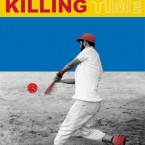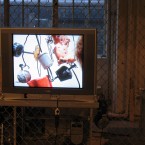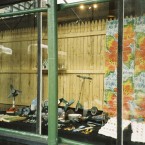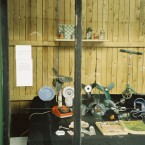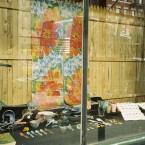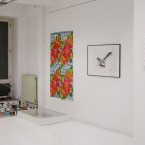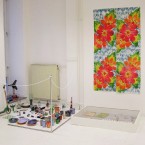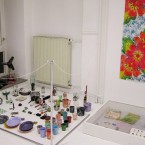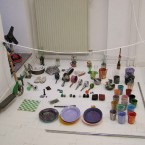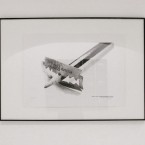- Killing Time poster
- Enemigo provisional
- Agua
- Agua
- Agua
Curated by Elvis Fuentes, Yuneikys Villalonga, and Glexis Novoa at Exit Art, New York, May 12 – July 28, 2007.
Killing Time focused on the work of over 70 contemporary Cuban artists that approached the subject of time. “The Revolution has been a symbolic intervention on Cuban Time. In return, time has shaped discourses of and on the Cuban Revolution,” said the curators. Time patterns: Rewriting History, Productive Journey vs. Free Time: From Diversion to Subversion, and Aging and Decaying: An Archaeology of Utopia, were some of many subjects explored in different media, including performances, installations, photographs, videos, drawings, paintings, sculpture, murals, prints and ephemera. This exhibition spanned from the late 1970s to the present, and provided a timely context for Cuban artists whose work had little or no exposure in the United States. Many of these artists metaphorically recorded some of the tensions in the cultural, social and political landscape of the past three decades, and were often dismissed by the official discourse on the Island or stereotyped by narrow conceptions of identity. A special section of the exhibition featured the origins of Performance and Conceptual art in Cuba, through original works and documentation materials never before shown in the United States.
Events: May 13, 2007, a panel discussion with Glexis Novoa, Rafael Lopez Ramos, Ruben Torres Llorca, Maria Magdalena Campos Pons, Tania Bruguera, and Leandro Soto; a Cuban dinner provided by Havana Nights; and live performances by Tania Bruguera, Juan-Si Gonzalez, Alejandro Lopez, Maritza Molina, El Soca and Fabian Leandro Soto;June 16 and June 23, 2007 , Tropical Area, an evening of performances by the Trickster Theater featuring works by Rob Andrews, Eun Woo Cho, Saeri Kiritani, Julia Mandle, Oleg Mavromatti, Jolie Pichardo, Pasha RA, Boryanna Rossa, Rafael Sanchez with Jesus Sendòn and Aki Sasamoto
Publication: The catalog for Killing Time, placed in a unique box, includes a 74-page book with four essays in English and Spanish by the curators (Elvis Fuentes, Yuneikys Villalonga and Glexis Novoa) and Exit Art Co-founder/Cultural Producer Papo Colo; a DVD with video documentation of the exhibition; a DVD of the Trickster Theater performance Tropical Area; color reproductions of each of the artists’ works.
Read more:Killing Time Artforum (periodical) by Morgan Falconer, July 12, 2007.It’s difficult to suggest curatorial distinction and narrative development when you’re organizing an exhibition for Exit Art’s capacious, hangarlike space. The problem is exacerbated when you work with over eighty very different artists. For this exhibition, curators Elvis Fuentes, Yuneikys Villalonga, and Glexis Novoa present Cuban artists, some of whom are exiles in New York and Miami and some of whom remain at home. Rather than imposing rigid order, they instead set the mood convincingly with a few large-scale works and then sensitively juxtapose similar pieces along the nearby walls.Fidel Castro is a recurrent, ghostly presence: One imagines him in the seat of Alejandro Lopez’s Bunker of Thoughts, 2006, a booming public-address system that resembles a gun emplacement. And the show’s theme—the sense of hiatus he has created in Cuba—is elaborated in various works: In Rigoberto Quintana’s Cuban Calendar, 2007, the leader presides over every year since the revolution, yet the picture, the same each year, is of an elderly, maybe even dead Castro, lying horizontal against a bloodred backdrop. Given the dominance of national politics in our conception of the island nation, it is surprising how few other works address the topic. Instead, we see only its effects: Liudmila Velasco and Nelson Ramirez’s photographic sequence Those Who Are No Longer Here, 2004–2006, depicts the homes of departed friends. We also see artists responding to familiar concerns like feminism: Maritza Molina photographs a nude woman hauling a cart full of suited men through a field in Carrying Tradition #2, 2005. Taken as a whole, the exhibition is revelatory and intriguing. One only wishes a catalogue had accompanied it, to lend a greater sense of order and context.